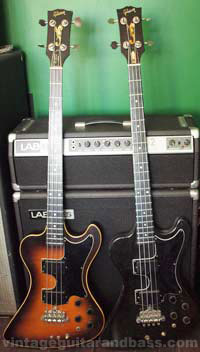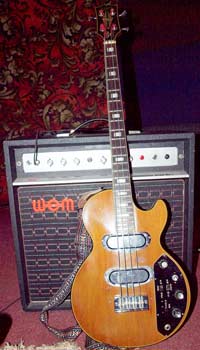

In the late 1970s musical giant Norlin, was the parent company to both Gibson and Moog. But Norlin gets a bad press in vintage guitar circles, after all they were better known as a beer company. But what do you get if you put Gibson and Moog together? The RD Artist I hear you all cry - correct, but also the LABseries of guitar and bass amplifiers. And do you know what? The RD Artist and LABseries amps sound great together! The L5 guitar amp is well-respected but you hear very little about the bass amps. I've just got hold of a LABseries L2 bass amp - it's a 100 watt, solid-state head with a separate cab housing a 15" speaker. It's a bit bigger and heavier than a lot of 15" bass rigs i've used, and perhaps not something I intend to play out so much, but it does sound superb with the right bass. I've tried a number of Norlin-period Gibsons through it, but the one that really shines is my 1981 RD Artist. They definitely seem to complement each other. But with such an array of sounds from both guitar and amp, it's hard to know where to start. I haven't tried any of my Victory basses through it yet, but they are on my to do list. Soundclips with the RD are not on the site yet either, but should be following over the next few days. comment
But, that leads to another late 1970s bass that I have recorded through the LABseries L2 - the Guild B302; i've been playing a rather nice 1978 fretless B302F this week; and what a sweet-sounding, highly-playable bass. It's no secret that Guild had stockpiles of great wood in the 1970s, that were turned into very well-built guitars. This longscale, all-mahogany bass is quite unlike the majority of fretless basses available at the time, or since for that matter, yet these basses don't sell for anything like what they are worth. Seriously undervalued instruments. Have a listen or a closer look. comment
Seeing as we're on a 70s tip, let's continue the theme with another bass i've been playing a lot this year, my 1974 Gibson Ripper. It's the older body style, and clearly an early one, but seemingly with an alder body. An interesting thing about this bass, as opposed to my 1978 ebony Ripper, is the real 'snap' that comes from the maple fingerboard... and it changes what you play. Guitars that sound and feel differently do tend to make you come up with different lines; and I got pretty funky at rehearsals with this bass. There are a lot of sounds in a Gibson Ripper, with Bill Lawrence's Q-system electronics, but the tendency can be to leave all the controls on 10, and just use the varitone to select a tone. Gibson knew this, and released a vinyl 45 rpm record in 1974 with a bunch of selected settings; and what an interesting disk. If you own a Gibson Ripper, or are thinking of owning one, you absolutely have to check it out. Not only does it suggest some great tonal settings, there is also some gritty funk by Richard Evans/Phil Upchurch and Dartanyon Brown/Chase. Or you can listen to my soundclips, replicating some of these settings through a '64 Ampeg B15 here. (You can check out many more soundclips of vintage guitars through vintage amps here. comment

Although i'm enjoying my new LABseries solid state amp, I generally prefer valve amps, and have a real soft spot for WEMs. If you follow this site you'll find lot's more related content over the coming months. One particular amp i've used in the studio a lot this year is the WEM Dominator bass MK 1; again it has a 15" cone - a Celestion G15M greenback, but only 15 watts. Introduced in the early 1970s as a companion to the Dominator guitar amps, and probably largely unknown outside the UK. It's got a terrific dirty snarl, great for recording, though probably not powerful enough for anything but the smallest gigs. I've got soundclips of mine on the site with a number of vintage basses: a 1961 EB3, a 1966 EB0 and a 1966 Hagstrom Coronado bass. Listen to the soundclips - especially those using the bridge or both pickups. I love this amp!
As I said, I have used this in the studio with a few bands in 2012, most notably with a session for Long John Laundry at Lost Boys in the Buckinghamshire countryside: the bass was my old favourite Les Paul Triumph. The result can be heard in the video to the right (don't confused by the non reverse Thunderbird shown) - it's interesting how the snarly tone is far less apparent once it sits in the mix.
Like the Guild B302 these don't get the attention they deserve, but I suppose today's bass players tend to prefer more hi-fi equipment. But this does mean you can pick these up pretty cheaply in the UK - £150 seems about normal, but as with all old amps that have probably sat untouched for decades, you probably want to factor in the cost of a service when you buy. comment

The Kalamzoo KB bass was Gibson's attempt at out-Fendering Fender; a simple to constuct bass with a nice neck and quality components. It came in Mustang and SG versions. I like these basses; they look cool play well, and whilst I prefer the richness of a set neck EB bass, quite a lot of people i've played with say they prefer the sound of these...

The SG-style Gibson Melody Makers are pretty nice guitars for their price-point. Gibson quality construction but with the simple fittings. Perhaps not as good looking as the doublecut versions that preceded them...

The earliest Vox Stroller guitars were copies of the 1950s Guyatone LG50; interesting to a Vox collector, but not the kind of thing you'd want to gig. Very lightweight indeed. Have a closer look at a 1963 Vox Stroller.

The early sixties Gibson Melody Makers were great little guitars, aimed at guitar students, but beautifully put together and finished instruments. Have a closer look at a 1964 double cutaway Melody Maker.
And don't forget you can now follow FlyGuitars / VintageGuitar website on facebook.
$3500
$9000
$3800
$3999
$4000
$4000
$2800
$55
$224